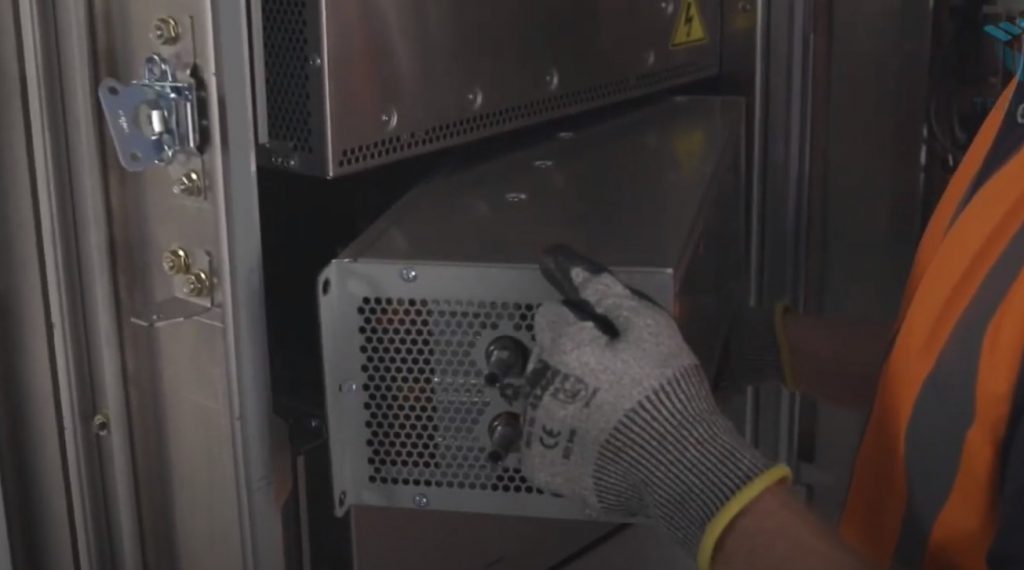
This evening at the Brisbane convention & exhibition centre, Tritium announced their new range of electric vehicle chargers.
While Aussie company already supply DC fast chargers to 38 countries around the world, the company just announced a new hardware platform that has some big implications.
The new hardware platforms aims to address the rapidly growing demand from an increase in electric vehicle sales globally. Typically chargers are added at 2, or 4 at a time, but to meet the adoption rate in coming years, mean that charging stations need to be installed on a much larger scale.
To accelerate the rollout of charging, Tritium is changing things considerably with a new approach to charging infrastructure, something that is typically very expensive.
Using a new Modular Scalable Charging (MSC) Platform, Tritium is now able to offer 12 chargers at the price of 7. At close to half the price of typical DC fast chargers, the new design shifts half of the charging infrastructure from inside the charger, to a centralised location, which is then shared across the chargers in that charging facility.
Tritium says this is a far more capitally efficient way of deploying chargers.
Tonight Tritium launched the first product in the series, the RTM 75. The charger can be deployed using 3-phase power, present in most commercial locations.
This 3rd generation charger from Tritium, features a simultaneous charging feature, which means charging speeds are not reduced when two EVs are charging from the same charger. For an owner, this has the potential to increase revenue, with more charging sessions possible per day.
The charger is also configurable with CCS CHAdeMO connectors and could have 1 of each, or 2 of the same. Typically we’ve seen chargers offer one of each, but CCS is definitely taking a strong lead internationally, so there’s like plenty of scenarios where we see companies deploy dual CCS chargers.


The charger now comes with 6 meter charging cables, which allow it to comfortable reach the charging port of any vehicle. This was demonstrated on stage and looks to be a significant upgrade on their existing chargers.
The charging cable hangs in a loop on the side of the device, and once the length of the cable is reached, you can actually pull it even further as the top mounts are retractable, offering the ability to plug in your EV, regardless of the orientation of your car.


The new LCD display has increased viewing angles which will certainly help when in direct sunlight.
When it comes to customers paying for their charging session, there’s now a credit card reader integrated into the front of the charger body. Tritium says they can integrate any credit card reader and have already integrated 2 different models.
Here’s the kicker, the RTM charger can be installed in just 2 hours. If you’re planning on installing them at your workplace, you can customise the appearance of them with front and back decals. This can act as a promotional surface for your business.


Tritium have maintained a IP65 rating, ensuring it’s protected against the environment.
Should the charger need servicing, that’s made significantly easier, thanks to a single secure screw, which one removed can then be accessed by a trained professional to perform the maintenance.








Inside the charger, we can see the modular construction. Starting with the bottom, the input circuit is easily configurable, based on the power requirements for the part of the world they’re shipping the charger to.
Above that are the 2x rectification units. To support the high power levels of fast chargers, an AC-to-DC rectifier is used in conjunction with a 3 phase AC input.
Above that are the DC-DC units that are actually delivering power to the car, in this instance up to 75kW, but Tritium announced their platform is capable of 350kW and beyond.
Build into the back of the door is the charge control module and the daughter boards responsible for handling the different charging standards The payment terminal is also easily replaceable, changeable if you need to switch it out to support RFID like tap and pay.
At the very top of the charger, there’s a DC meter which measures the amount of energy flowing to the car, or cars.
The last module that was installed live, provided a great opportunity to see how easy the installation is. The right side of the module provides the electrical connection, while the left side provides liquid cooling.
Tritium was making a big deal about the serviceability of this charger. With their new modular design, this opens the door to single-person servicing, and each module weighs a maximum of 16kgs.
Along with the RTM75, Tritium announced a couple of other products in their lineup, aimed at ultra-fast charging.
The RTM is designed for retail, while the PKM is designed for building out a charging park.
The PKM chargers will come in two variants, 150kW or 350kW depending on how many modules you install. This modular design should provide Tritium and their customers with significant cost savings. These 2 chargers are due for release in 2021.
What’s neat about the PKM design, is that being a DC fast charger, there’s no need for the two rectification modules at the bottom, which enables that space to be used for more charging units.


Now let’s get to DPM, this is the big boy, a charger like we’ve never seen before, this is for depots. Depots are typically for fleets of commercial vehicles and yes, even trucks like Tesla Semi.
Coming in 2022, the DPM will be available in 150-3,000kW options. That really is a staggering number. It is expected the Tesla Semi could have up to a 1 Megawatt battery, this charger could theoretically charge 3 Tesla Semi’s at once.. WOW.
In reality, the charger has two connectors, so it’d only be possible to charge 2 simultaneously, but this infrastructure leap is what’s required to deal with the commercial transition away from fossil fuels.
More information at https://tritiumcharging.com/
